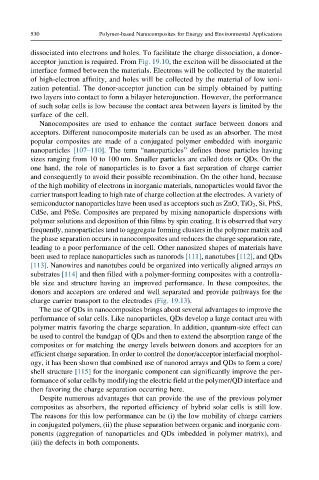Page 577 - Polymer-based Nanocomposites for Energy and Environmental Applications
P. 577
530 Polymer-based Nanocomposites for Energy and Environmental Applications
dissociated into electrons and holes. To facilitate the charge dissociation, a donor-
acceptor junction is required. From Fig. 19.10, the exciton will be dissociated at the
interface formed between the materials. Electrons will be collected by the material
of high-electron affinity, and holes will be collected by the material of low ioni-
zation potential. The donor-acceptor junction can be simply obtained by putting
two layers into contact to form a bilayer heterojunction. However, the performance
of such solar cells is low because the contact area between layers is limited by the
surface of the cell.
Nanocomposites are used to enhance the contact surface between donors and
acceptors. Different nanocomposite materials can be used as an absorber. The most
popular composites are made of a conjugated polymer embedded with inorganic
nanoparticles [107–110]. The term “nanoparticles” defines those particles having
sizes ranging from 10 to 100 nm. Smaller particles are called dots or QDs. On the
one hand, the role of nanoparticles is to favor a fast separation of charge carrier
and consequently to avoid their possible recombination. On the other hand, because
of the high mobility of electrons in inorganic materials, nanoparticles would favor the
carrier transport leading to high rate of charge collection at the electrodes. A variety of
semiconductor nanoparticles have been used as acceptors such as ZnO, TiO 2 , Si, PbS,
CdSe, and PbSe. Composites are prepared by mixing nanoparticle dispersions with
polymer solutions and deposition of thin films by spin coating. It is observed that very
frequently, nanoparticles tend to aggregate forming clusters in the polymer matrix and
the phase separation occurs in nanocomposites and reduces the charge separation rate,
leading to a poor performance of the cell. Other nanosized shapes of materials have
been used to replace nanoparticles such as nanorods [111], nanotubes [112], and QDs
[113]. Nanowires and nanotubes could be organized into vertically aligned arrays on
substrates [114] and then filled with a polymer-forming composites with a controlla-
ble size and structure having an improved performance. In these composites, the
donors and acceptors are ordered and well separated and provide pathways for the
charge carrier transport to the electrodes (Fig. 19.13).
The use of QDs in nanocomposites brings about several advantages to improve the
performance of solar cells. Like nanoparticles, QDs develop a large contact area with
polymer matrix favoring the charge separation. In addition, quantum-size effect can
be used to control the bandgap of QDs and then to extend the absorption range of the
composites or for matching the energy levels between donors and acceptors for an
efficient charge separation. In order to control the donor/acceptor interfacial morphol-
ogy, it has been shown that combined use of nanorod arrays and QDs to form a core/
shell structure [115] for the inorganic component can significantly improve the per-
formance of solar cells by modifying the electric field at the polymer/QD interface and
then favoring the charge separation occurring here.
Despite numerous advantages that can provide the use of the previous polymer
composites as absorbers, the reported efficiency of hybrid solar cells is still low.
The reasons for this low performance can be (i) the low mobility of charge carriers
in conjugated polymers, (ii) the phase separation between organic and inorganic com-
ponents (aggregation of nanoparticles and QDs imbedded in polymer matrix), and
(iii) the defects in both components.

